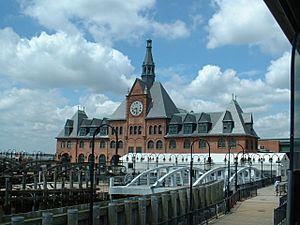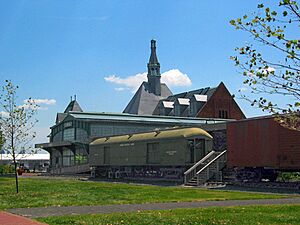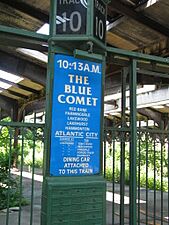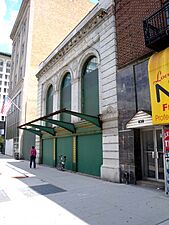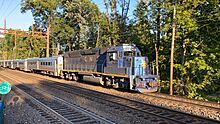Central Railroad of New Jersey facts for kids
| Jersey Central, Jersey Central Lines or New Jersey Central | |
 |
|
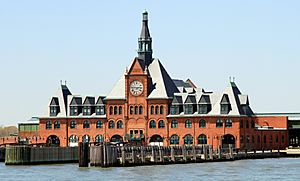
|
|
| Overview | |
|---|---|
| Main region(s) | New Jersey |
| Other region(s) | New York State Pennsylvania |
| Headquarters | 148 Liberty Street New York City, New York, U.S. |
| Reporting mark | CNJ |
| Dates of operation | 1839–1976 |
| Successors | Conrail (freight) Raritan Valley Line (passenger) |
| Technical | |
| Length | 693 miles (1,115 kilometres) |
The Central Railroad of New Jersey, often called the Jersey Central or CNJ, was a big railroad company in the United States. It started way back in the 1830s. The CNJ was one of the main railroads in the Northeastern United States.
It became part of a larger company called Conrail in April 1976. This happened along with several other railroads that were having financial problems.
The CNJ's main train line was very important in New Jersey. Today, most of this line is used for passenger trains by the Raritan Valley Line. Other parts of the old CNJ tracks are now used by freight trains.
Contents
History of the Central Railroad of New Jersey
Early Days: The 1800s


The very first part of what became the CNJ was the Elizabethtown & Somerville Railroad. It was created in 1831. This short line opened in 1836, running from Elizabethport to Elizabeth, New Jersey.
At first, horses pulled the trains! But by 1839, steam engines were used. The railroad grew, reaching Somerville in 1842. In 1847, another company, the Somerville and Easton Railroad, began building tracks further west.
In 1849, the Somerville and Easton bought the Elizabethtown & Somerville. They changed their name to the Central Railroad Company of New Jersey. The line reached Phillipsburg in 1852. This town is on the east side of the Delaware River.
The railroad then extended east to Jersey City in 1864. It also added smaller lines to towns like Flemington and Newark.
The New Jersey Southern (NJS) railroad started building tracks in 1860. It went across southern New Jersey. The CNJ took control of the NJS in 1879. This helped the CNJ reach more places.
The CNJ also had lines in Pennsylvania. These were built by the Lehigh Coal & Navigation Company. The main line there was finished in 1866. It connected Phillipsburg, New Jersey, to Wilkes-Barre. A special part of this line was the Ashley Planes. This was a very steep section where trains were pulled by cables. It was used until after World War II.
Most of the trains in Pennsylvania carried anthracite coal. This was a very important type of coal. Later, a law made it so railroads couldn't carry goods they owned.
From 1883 to 1887, another company, the Philadelphia & Reading Railroad, operated the CNJ. They worked together to create a route between New York and Philadelphia. The CNJ started managing itself again in 1887.
The main repair shops for CNJ trains were in Elizabethport, New Jersey. In 1901, new, modern shops were built there. They could fix many locomotives and freight cars each year. There were also important facilities in Jersey City, New Jersey, near Manhattan. These included places to store and repair trains.
The 1900s: Growth and Changes

In 1901, the Reading Company gained control of the CNJ. Around the same time, the Baltimore & Ohio Railroad (B&O) gained control of the Reading Company. This meant the B&O could use CNJ tracks to reach New York City.
In 1929, the CNJ launched a special train called the Blue Comet. This fancy train ran twice a day between Jersey City and Atlantic City. It was painted bright blue and offered very comfortable seats. The Blue Comet was an early example of modern, fast passenger trains. It stopped running in 1941 because more people started driving cars.
Also in 1929, the CNJ bought a part of the Raritan River Railroad. This was a smaller, 12-mile long line. The CNJ also bought other smaller railroads in the early 1930s.
After World War II, fewer people rode trains. Most of the CNJ's passenger business was for people commuting to work. This meant trains were very busy for short times each day. Most of the CNJ's freight (goods) traffic ended on its own lines. This made it harder for the railroad to make a lot of money. Also, high taxes in New Jersey made things difficult.
In 1946, the CNJ's lines in Pennsylvania were set up as a separate company. This was an attempt to avoid some of the high taxes in New Jersey. But the CNJ took back control of these lines in 1952.
In 1965, the CNJ and the Lehigh Valley Railroad combined some of their tracks in Pennsylvania. This was because the coal business that supported both railroads had mostly disappeared. CNJ stopped its operations in Pennsylvania on March 31, 1972.
The CNJ also had a small terminal in The Bronx for moving train cars by boat. It also had many boats and ferries in New York Bay. This included a ferry line to Manhattan.
On April 30, 1967, the CNJ's last ferry trip between Manhattan and its Jersey City terminal took place. The next day, CNJ passenger trains started using the PRR station in Newark. Passengers could then transfer to other trains to get to New York City.
In 1976, Conrail took over the CNJ's freight operations. Passenger routes were given to the New Jersey Department of Transportation. Today, these routes are part of New Jersey Transit.
After going through financial difficulties, the CNJ company changed its name several times. In 1986, it merged with a packaging company.
Main Train Routes
The CNJ's main starting point in the northeast was at Elizabethport, New Jersey. In 1864, the CNJ extended its tracks across the bay to Bayonne and then north to its terminal in Jersey City. They used several bridges over the years, with the last one being taken down in the 1980s.
From Elizabethport, trains went in different directions. One route went west towards Elizabeth and Plainfield. Another went south towards Perth Amboy and the areas that are now part of the North Jersey Coast Line. The CNJ also ran trains into Pennsylvania and other western or southern places. Other railroads, like the B&O, also used CNJ tracks to reach Jersey City.
Parts of the CNJ Still Used Today
Many parts of the old CNJ railroad are still used for trains today!
- Aldene-High Bridge (Main Line): Used by New Jersey Transit (NJT) for the Raritan Valley Line.
- Perth Amboy-Bay Head: Used by NJT for the North Jersey Coast Line.
- Elizabethport-Aldene; Elizabethport-Perth Amboy; Jersey City-Bayonne; Red Bank-Lakehurst: Used by Conrail Shared Assets Operations for freight.
- Lakehurst-Woodmansie: Used by Cape May Seashore Lines.
- Winslow Junction-Vineland: Used by Southern Railroad of New Jersey.
- Dover & Rockaway Branch (Wharton-Rockaway); High Bridge Branch (Kenvil-Flanders): Used by Morristown & Erie Railway.
- White Haven PA - Laurel Run PA: Used by Reading Blue Mountain and Northern.
Gallery
-
Communipaw Terminal, Jersey City
Railroads that Became Part of CNJ
Many smaller railroads joined or were bought by the CNJ over the years. Here are some of them:
- Buena Vista Railroad
- Carteret & Sewaren Railroad
- Carteret Extension Railroad
- Cumberland & Maurice River Railroad
- Cumberland & Maurice River Extension Railroad
- Elizabeth Extension Railroad
- Freehold & Atlantic Highlands Railroad
- Lafayette Railroad
- Manufacturers' Extension Railroad
- Middle Brook Railroad
- New Jersey Terminal Railroad
- New Jersey Southern Railroad
- Navesink Railroad
- Passaic River Extension Railroad
- Raritan North Shore Railroad
- Sound Shore Railroad
- Toms River Railroad
- Toms River & Barnegat Railroad
- Vineland Railroad
- Vineland Branch Railway
- West Side Connecting Railroad
- West End Railroad
Famous Passenger Trains of the CNJ
The CNJ operated several well-known passenger trains, many of which traveled between states:
- Blue Comet: From Jersey City, New Jersey to Atlantic City, New Jersey.
- Bullet: From Jersey City to Wilkes-Barre, Pennsylvania (going through Allentown, Pennsylvania).
- Crusader: From Jersey City to Philadelphia, Pennsylvania (with the Reading Company).
- Interstate Express: From Syracuse, New York to Philadelphia, Pennsylvania (with other railroads).
- Mermaid: From Sandy Hook, New Jersey to Scranton, Pennsylvania.
- Queen of the Valley: From Jersey City to Harrisburg, Pennsylvania (with the Reading Company).
- Wall Street: From Jersey City to Philadelphia, Pennsylvania (with the Reading Company).
- Williamsporter: From Jersey City, New Jersey to Williamsport, Pennsylvania.
Some trains from other companies also used CNJ tracks to reach the Jersey City terminal:
- Capitol Limited: From Jersey City, New Jersey to Chicago, Illinois (B&O train).
- National Limited: From Jersey City, New Jersey to St. Louis, Missouri (B&O train).
- Royal Blue: From Jersey City, New Jersey to Washington, D.C. (B&O train).
Heritage Units: Remembering the CNJ
To celebrate its 30th birthday in 2012, a company called Norfolk Southern painted 20 new locomotives. One of them, NS #1071, was painted in the CNJ's classic orange and blue colors! This was a way to honor the CNJ's history.
In 2019, NJ Transit also painted one of their locomotives, #4109, to look like an old CNJ train. It's a cool way to see a piece of railroad history still running today!


